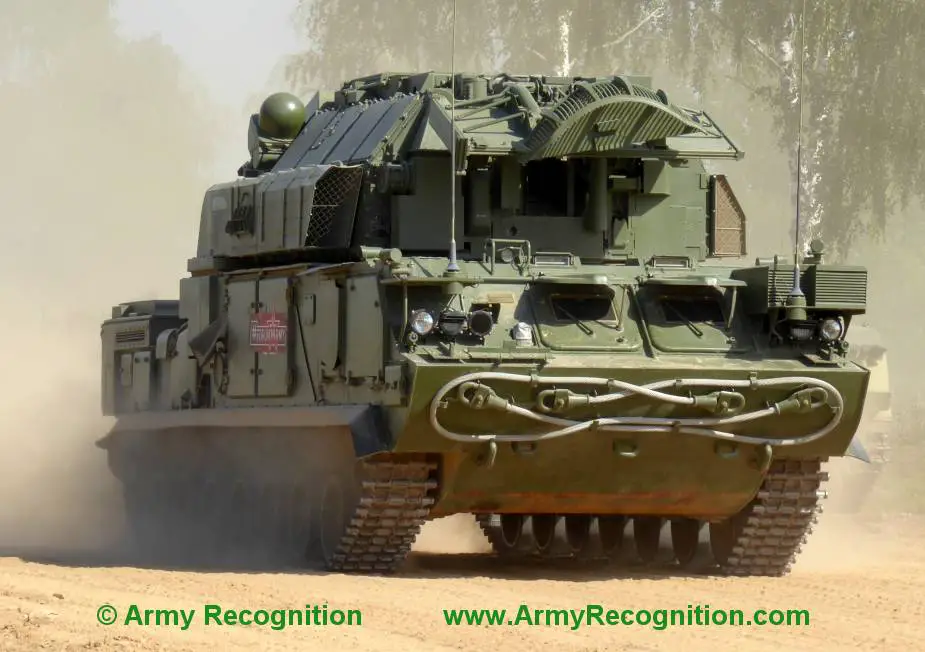The Tor-M2 family (NATO reporting name: SA-15 Gauntlet) surface-to-air missile (SAM) systems will form the backbone of the Russian military’s short-range air defense (SHORAD) in years to come, according to Russian media.
Follow Army Recognition on Google News at this link

Tor-M2 (Picture source: Army Recognition)
In 2019, the developer of the Tor SAM (Surface-to-Air Missile) system, Izhevsk Electromechanical Plant (IEMZ) Kupol (a subsidiary of the Almaz-Antey Corporation), signed a large contract for the delivery of tracked and Arctic Tor air defense weapons to the Russian Ministry of Defense (MoD). The original Tor system was developed some 35 years ago, and it has seen no less than three major upgrades, namely, Tor-M1 (1991), Tor-M2U (2009), and Tor-M2 (2016). The weapon’s target detection capabilities have been dramatically reinforced: the latest variant of the system, Tor-M2E, is capable of engaging up to four aerial targets in a simultaneous manner and has a target engagement probability close to 100%.
The Tor-M2 is armed with 16 ready-to-use SAMs and can fire the latest 9M338K missiles. According to the developers, it is the only air defense weapon that can engage aerial targets on the move. The export-oriented variant of the system, Tor-M2E, shoots down targets at distances between 1,000 m and 15,000 m and at altitudes between 10 m and 10,000 m.
It should be mentioned that IEMZ Kupol has designed a stationary Tor variant to protect critically important pieces of infrastructure. The system, which is designated Tor-M2KM, provides round-the-clock protection against both fixed-/rotary-wing aircraft and air-launched weapons (including cruise missiles, anti-radiation weapons, guided and gliding bombs, and unmanned aerial vehicles (UAVs). The system shields both state objects and industrial complexes, including oil and gas storages, sea-banks, various power stations, plants, large bridges, railroad stations, airports, sea and river vessels, etc. The Tor-M2KM’s combat module (CM) can be transported by either medium/heavy transport fixed-wing aircraft or heavy helicopters.
The CM integrates a target detection system, a guidance system with two autonomous missile guidance channels, around-the-clock backup optical-electronic subsystem, and communications assets. The module is armed with up to eight ready-use missiles in two four-cell canisters. The manufacturer claims that a CM protects a 700 km2 area against aerodynamic targets and a 150 km2 area — against high-precision weapons; when a four-unit Tor-M2KM battery is employed, these figures increase to 1,250 km2 and 450 km2, respectively.
Russia largely invests in the development of the Tor SHORAD weapon family. In mid-June 2020, Commander of the Russian Armed Forces’ tactical air defense Lieutenant-General Alexander Leonov told the National Defense magazine that a variant of the Tor-M2 on an amphibious chassis was being developed. According to Leonov, the Tor-family systems have shown good operational experience in Syria. “Since the beginning of its combat duty, the vehicles destroyed more than 45 improvised UAVs,” he noted. The Russian military is set to receive new Tor-M2 and Arctic Tor-M2DT vehicles through 2027, said the general.
IEMZ Kupol is reported to be developing a marinized modification of the Tor. The system, which is designated Tor-MF, is said to break its cover in the early 2020s.
There are at least two known wheeled options of the Tor-M2KM carrier: the system is transported by an Indian-made TATA 8×8 truck or a KAMAZ-6350 automotive vehicle. However, the CM can be carried by almost all heavy trucks, for instance, MAN The Tor-M2 is reported to be effective against modern threats such as unmanned aerial vehicles and guided munitions. During the Armenian-Azeri conflict on Autumn 2020, the system was said to be capable of engaging Bayraktar TB2 UCAVs.
© Copyright 2021 TASS / Army Recognition Group SPRL. All rights reserved. This material may not be published, broadcast, rewritten or redistributed.















